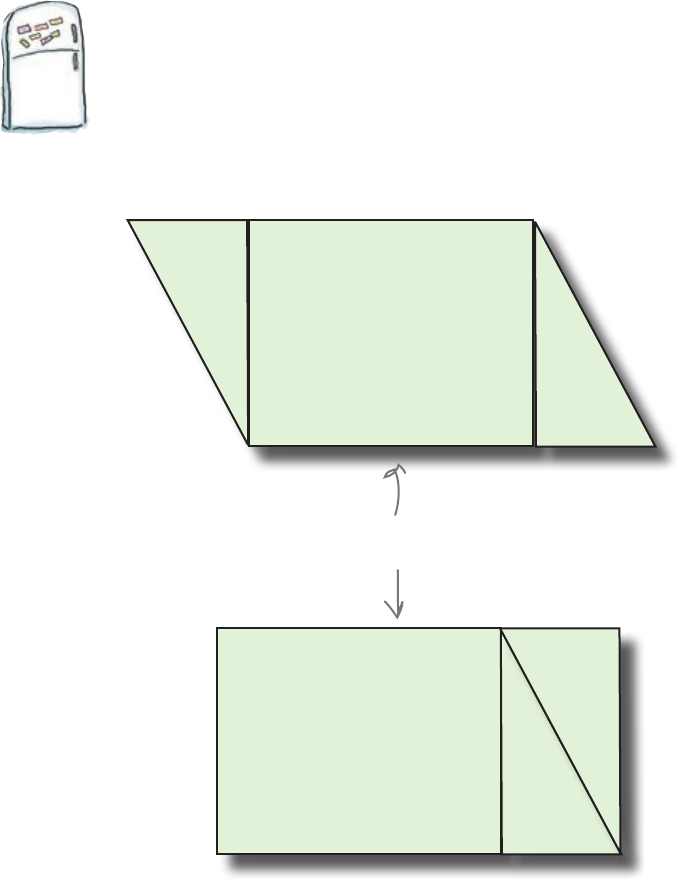
Look f
amiliar? It’s the
same f
ormula y
ou’d use
t
o ca
lcula
te the ar
ea
of a r
ec
tangle.
T
he dotted line s
hows
W
e mov
ed the end triangle
t
o f
orm a r
ec
tangle.
quadrilaterals
If you don’t like what you’re given, change it
True, geometry has lots of rules, but moving things around doesn’t mean you’re
breaking them. By moving the shapes you created in the parallelogram around,
you were able to form a rectangle. And you know that it has the same height and
same base width as the original parallelogram. So now…you know how to find
the area of a parallelogram!
Width
the s
hap
e of the
original para
llelogram.
Height
Parallelogram Area = Base Width × Height
Here’s a new parallelogram lawn you’ve been asked to mow. What
should you charge for mowing it?
45 meters
16 meters
34 meters
you are here 4 245

sharpen solution
Here’s a new parallelogram lawn you’ve been asked to mow. What
should you charge for mowing it?
Parallelogram area = 45 x 16
= 720 meters
2
Mowing charge = $0.10 x 720
= $72.00
45 meters
16 meters
34 meters
Q:
What if I only have one pair
of opposite sides? Do I still have a
parallelogram?
A:No. In order for a shape to be a
parallelogram, both pairs of opposite sides
must be parallel. If you only have one pair
of opposite parallel sides, your shape isn’t a
parallelogram.
Q:
Can I still use the same formula
for finding the area for that shape?
A:This formula is specific to
parallelograms. But keep reading,
we’re going to cover more than just
parallelograms and we might have just the
formula you need.
Q:
What if I only know the length of
the sides of a parallelogram and not the
height? Can I still work out the area?
A:You can’t, because you need to know
what the height is. The reason for this is
that the degree to which the parallelogram
“slants” can make a big difference to the
overall area. As an example, if the sides
of a parallelogram are tilted so that they’re
almost horizontal, you’ll have a much
smaller area than if the sides are almost
vertical.
Q:
But what if I have extra
information such as the internal angles
of the parallelogram? Can I work out the
area then?
A:Yes, it is possible to find out the area,
but it takes a bit more work, not to mention
some trigonometry!
Q:
Are opposite sides always the
same length?
A:Yes they are, because opposite sides
of a parallelogram are always congruent
(same angle, same length). If opposite
sides are different lengths, you don’t have a
parallelogram.
Q:
What about opposite angles? They
look the same to me.
A:Yes, for parallelograms opposite
angles are always congruent. Similarly,
consecutive angles are supplementary. You
can use the angle skills you developed
earlier in the book to work this out.
246 Chapter 6
Get Head First 2D Geometry now with the O’Reilly learning platform.
O’Reilly members experience books, live events, courses curated by job role, and more from O’Reilly and nearly 200 top publishers.

